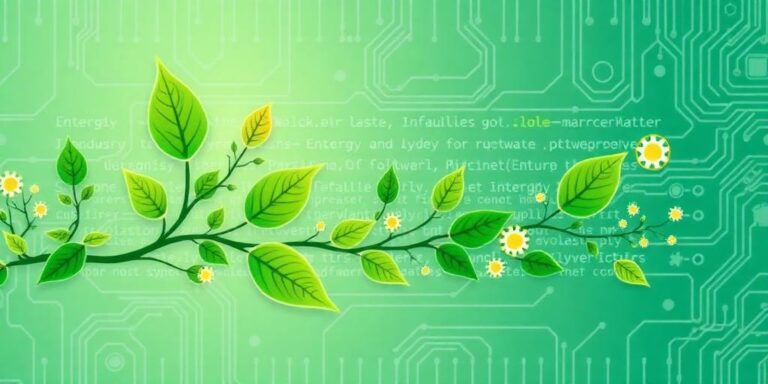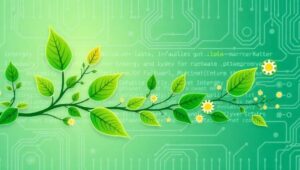Green Software Engineering: Writing Energy-Efficient Code (2026)
In 2026, the urgency for sustainable software development is no longer a future aspiration but a present necessity. Green software engineering, the practice of writing energy-efficient code, has evolved from a niche concept to a core principle in software development. This article explores the essential strategies, technologies, and best practices that define green software engineering in 2026.
The Imperative for Green Software
By 2026, the environmental impact of software is substantial. Data centers consume vast amounts of electricity, and the proliferation of IoT devices and cloud services has further increased energy demands. Green software engineering addresses these challenges by minimizing the energy footprint of software applications.
Key Principles of Green Software Engineering
Several key principles guide the development of energy-efficient software:
- Energy Efficiency: Optimize code to reduce CPU usage and memory consumption.
- Carbon Awareness: Select hosting regions with renewable energy sources.
- Demand Shaping: Schedule non-urgent tasks during periods of low energy demand.
- Measurement: Continuously monitor and measure energy consumption.
- Optimization: Refine algorithms and data structures for efficiency.
Strategies for Writing Energy-Efficient Code
1. Optimize Algorithms and Data Structures
Efficient algorithms and data structures are fundamental to reducing energy consumption. In 2026, developers use advanced profiling tools to identify performance bottlenecks and optimize critical code paths.
- Profiling: Use tools like perf and Intel VTune to identify CPU-intensive functions.
- Algorithm Selection: Choose algorithms with lower time complexity (e.g., O(log n) instead of O(n^2)).
- Data Structures: Employ data structures that minimize memory usage and access times.
2. Reduce Network Usage
Network communication is a significant energy consumer. Minimizing data transfer and optimizing network protocols are essential for green software engineering.
- Data Compression: Use compression algorithms like gzip or Brotli to reduce data size.
- Caching: Implement caching mechanisms to reduce the need for repeated data retrieval.
- Protocol Optimization: Use efficient network protocols like QUIC instead of TCP.
3. Optimize Resource Utilization
Efficiently managing system resources such as CPU, memory, and disk I/O can significantly reduce energy consumption.
- Resource Pooling: Reuse resources instead of creating new ones for each task.
- Lazy Loading: Load resources only when they are needed.
- Asynchronous Processing: Use asynchronous operations to avoid blocking threads and wasting CPU cycles.
4. Use Green Cloud Services
Cloud providers are increasingly offering services powered by renewable energy. Selecting these services can significantly reduce the carbon footprint of software applications.
- Carbon-Neutral Regions: Deploy applications in cloud regions powered by renewable energy.
- Energy-Efficient VMs: Use virtual machine instances optimized for energy efficiency.
- Serverless Computing: Leverage serverless functions to minimize idle resource usage.
Tools and Technologies for Green Software Engineering
In 2026, a variety of tools and technologies support green software engineering:
- Energy Profilers: Software tools that measure the energy consumption of applications.
- Carbon Footprint Calculators: Tools that estimate the carbon emissions of software deployments.
- Green CI/CD Pipelines: Automated pipelines that integrate energy efficiency checks into the software development process.
- AI-Powered Optimization: Machine learning models that optimize code for energy efficiency.
Best Practices for Green Software Engineering
Adopting best practices is crucial for achieving sustainable software development:
- Education and Training: Educate developers on the principles and practices of green software engineering.
- Collaboration: Foster collaboration between developers, operations, and sustainability teams.
- Continuous Improvement: Regularly review and optimize code for energy efficiency.
- Policy and Governance: Implement policies that prioritize energy efficiency in software development.
The Future of Green Software Engineering
As we move further into the 2020s, green software engineering will become even more critical. Innovations in hardware, software, and cloud computing will continue to drive improvements in energy efficiency. By embracing these advancements and adhering to best practices, developers can play a vital role in creating a sustainable digital future.
Green software engineering in 2026 is not just a trend but a fundamental shift towards responsible and sustainable software development. By adopting the strategies, technologies, and best practices outlined in this article, developers can significantly reduce the environmental impact of their applications and contribute to a greener future.




